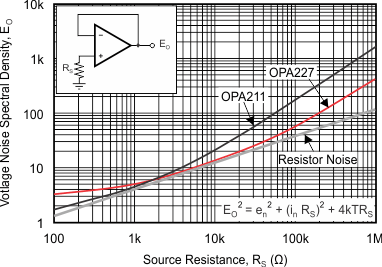JAJS198L October 2006 – January 2020 OPA211
PRODUCTION DATA.
- 1 特長
- 2 アプリケーション
- 3 概要
- 4 改訂履歴
- 5 概要(続き)
- 6 Pin Configuration and Functions
-
7 Specifications
- 7.1 Absolute Maximum Ratings
- 7.2 ESD Ratings
- 7.3 Recommended Operating Conditions
- 7.4 Thermal Information: OPA211 and OPA211A
- 7.5 Thermal Information: OPA2211 and OPA2211A
- 7.6 Electrical Characteristics: Standard Grade OPAx211A
- 7.7 Electrical Characteristics: High-Grade OPAx211
- 7.8 Typical Characteristics
- 8 Detailed Description
- 9 Application and Implementation
- 10Power Supply Recommendations
- 11Layout
- 12デバイスおよびドキュメントのサポート
- 13メカニカル、パッケージ、および注文情報
パッケージ・オプション
メカニカル・データ(パッケージ|ピン)
サーマルパッド・メカニカル・データ
発注情報
9.1.3 Noise Performance
Figure 45 shows total circuit noise for varying source impedances with the operational amplifier in a unity-gain configuration (no feedback resistor network, and therefore no additional noise contributions). Two different operational amplifiers are shown with total circuit noise calculated. The OPAx211 has very low voltage noise, making the family a viable option for low source impedances (less than 2 kΩ). A similar precision operational amplifier, the OPA227, has somewhat higher voltage noise but lower current noise. It provides excellent noise performance at moderate source impedance (10 to 100 kΩ). Above 100 kΩ, a FET-input operational amplifier such as the OPA132 (very low current noise) may provide improved performance. The equation in Figure 45 is shown for the calculation of the total circuit noise.
NOTE
en = voltage noise, In = current noise, RS = source impedance, k = Boltzmann’s constant = 1.38 × 10–23 J/K, and T is temperature in K.
 Figure 45. Noise Performance of the OPA211 and OPA227 in Unity-Gain Buffer Configuration
Figure 45. Noise Performance of the OPA211 and OPA227 in Unity-Gain Buffer Configuration